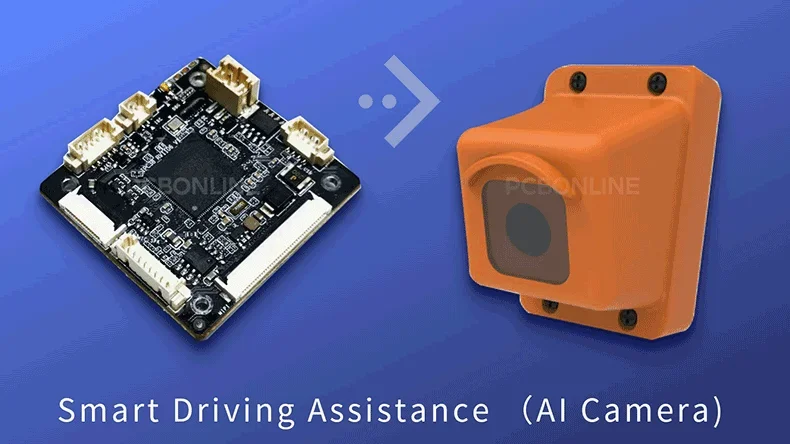
In this guide, we'll dive into what sets LoRa, WiFi, and BLE apart, and most importantly, help you determine which one suits your project best.
Once you've got your prototype all set up, keep in mind that companies like PCBONLINE help you move from the initial R&D stage to having professionally manufactured and assembled PCBs.
In this article:
Part 1. Overview of LoRa, WiFi, and BLE in IoT Part 2. Example Hardware Modules Part 3. Advantages & Disadvantages of LoRa, WiFi, and BLE Part 4. Real-World Applications and Best-Fit Technology From Concept to Product: PCB/PCBA Manufacturing with PCBONLINEOverview of LoRa, WiFi, and BLE in IoT
In today's rapidly evolving world of IoT, or the Internet of Things, picking the right wireless communication technology can make a difference for your project. Whether you're working on a smart farming solution, a fitness tracker, or a fully connected smart home, the way your device sends and receives data reliably is important.
When we talk about popular wireless protocols in the IoT arena, three names pop up quite a bit: LoRa, WiFi, and BLE, which stands for Bluetooth Low Energy. Each of these has its own perks and drawbacks, and they shine in different scenarios.
LoRa (Long Range)
LoRa is a low-power, long-range wireless technology optimized for small data packets over vast distances used in remote, outdoor environments.
- Range: Up to 15 km (line-of-sight)
- Data rate: 0.3–50 kbps
- Power consumption: Extremely low
- Best for: Agriculture, environmental monitoring, asset tracking
- Application example: wildfire alarm
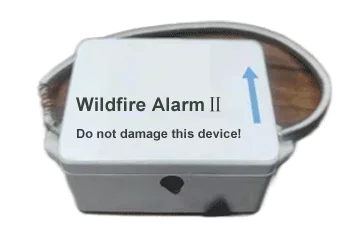
WiFi
WiFi offers high-speed data transmission and is ideal for applications that require frequent internet connectivity and high bandwidth, like smart home systems or surveillance.
- Range: 50–100 meters indoors
- Data rate: Up to several Gbps
- Power consumption: High
- Best for: Smart appliances, video cameras, cloud-connected devices
- Application example: smart door lock
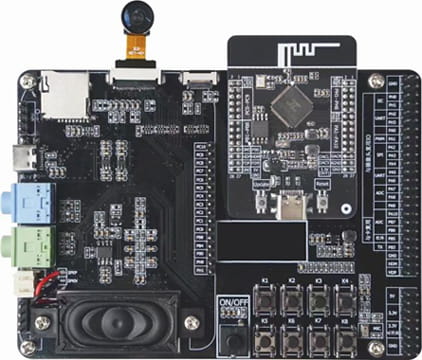
Bluetooth Low Energy (BLE)
BLE is designed for short-range, energy-efficient communication. It's a go-to choice for wearable devices and personal electronics.
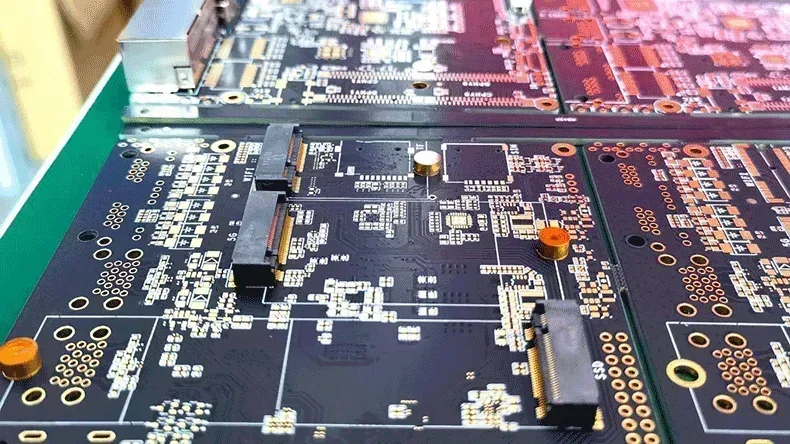
- Range: 10–100 meters (depending on the environment)
- Data rate: Up to 2 Mbps
- Power consumption: Ultra-low
- Best for: Wearables, fitness trackers, medical sensors
- Application example: face-ID check-in
Example Hardware Modules
Your wireless protocol choice influences hardware and PCB design. Here are some widely used modules that incorporate each protocol:
ESP32 – WiFi + BLE
The ESP32 is a dual-core microcontroller with integrated WiFi and BLE. It's low-cost and packed with features.
- Popular in: Smart home, wearables, industrial IoT
- Design note: ESP32-based designs are supported by PCB manufacturers like PCBONLINE, who can provide multilayer PCB fabrication, SMT assembly, testing for WiFi/BT signal integrity, enclosures, box-build assembly, IC programming, and value-added.
RAK4630 – LoRa + BLE
The RAK4630 combines LoRa and BLE, allowing for versatile deployments in rural or mobile IoT solutions.
- Popular in: Smart farming, GPS asset tracking
- Design note: LoRa designs typically require careful PCB antenna layout and RF shielding. A partner like PCBONLINE, with RF/high-frequency PCB experience, can help minimize signal loss and EMI.
HM-10 (BLE) & HC-05 (Classic Bluetooth)
These modules are simple and cost-effective for basic Bluetooth communication.
- Popular in: Low-cost IoT gadgets, hobbyist projects
- Design tip: For low-cost, high-volume production, PCBONLINE offers turnkey PCBA services, including sourcing of modules like HM-10 or equivalent chipsets for BLE.
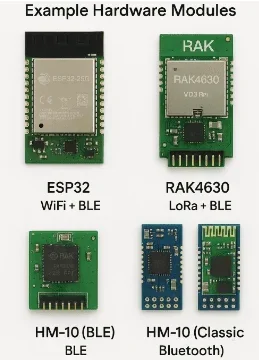
For a clearer comparison of LoRa, WiFi, and BLE, here is a feature comparison table.
|
Feature
|
LoRa
|
WiFi
|
BLE
|
|
Range
|
Up to 15 km
|
100 m max
|
Up to 100 m
|
|
Data rate
|
0.3–50 kbps
|
Up to Gbps
|
Up to 2 Mbps
|
|
Power use
|
Very low
|
High
|
Very low
|
|
Use case
|
Remote sensors
|
High-speed/cloud apps
|
Personal gadgets
|
|
Complexity
|
Medium
|
High
|
Low
|
|
Hardware cost
|
Moderate
|
Low
|
Very low
|
|
PCB considerations
|
RF shielding, antenna tuning
|
WiFi tuning, ground planes
|
Compact, low-layer boards
|
Advantages & Disadvantages of LoRa, WiFi, and BLE
LoRa, WiFi, and BLE all have their pros and cons.
LoRa
✅ Pros:
- Best-in-class range
- Low power use
- Ideal for rural or inaccessible environments
❌ Cons:
- Limited bandwidth
- Requires LoRaWAN gateways
- More complex hardware integration
PCBONLINE tip: When working with LoRa designs, precision in PCB layout matters. PCBONLINE can assist with RF simulation and antenna matching services to ensure reliable performance.
WiFi
✅ Pros:
- High-speed, reliable data
- Ubiquitous infrastructure
- Easy cloud connectivity
❌ Cons:
- High power draw
- Shorter range
- Potential network congestion
PCBONLINE insight: WiFi-enabled boards often need multilayer PCB designs with excellent grounding and thermal management. PCBONLINE provides impedance-controlled PCBs to meet these needs.
BLE
✅ Pros:
- Ultra-low power
- Direct smartphone compatibility
- Simple to implement
❌ Cons:
- Limited range
- Lower throughput
- No native internet access
PCB design note: For BLE-enabled products like fitness bands or tags, compact and cost-effective PCBs are essential. PCBONLINE's small-batch and bulk-production-friendly services help startups scale affordably.
Real-World Applications and Best-Fit Technology
Recommended tech: LoRa
Application: Smart agriculture (soil monitoring, irrigation control, etc.)
Why? / Description:
LoRa is great for sending data over long distances. It's perfect for those sensors out in the field communicating back to a central hub. And the best part? It works well for battery-powered devices with hardly any upkeep needed, even in those vast and remote areas.
Recommended tech: WiFi (ESP32)
Application: Smart home (switches, lights, thermostats, etc.)
Why? / Description:
Now, when you think about WiFi, it's all about that direct internet access. It really shines when it comes to cloud-based control and automation. Plus, with the ESP32 chip, manufacturers can whip up smart devices that are both affordable and packed with features.
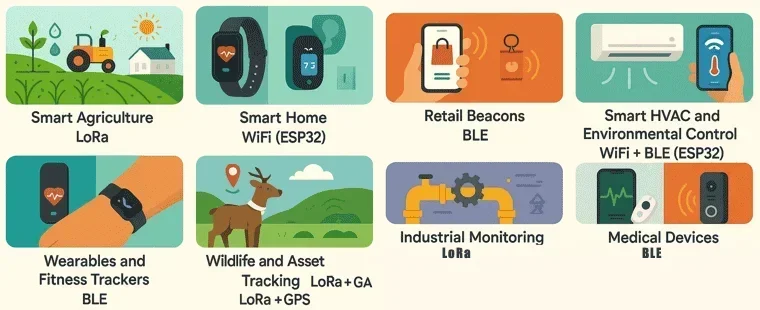
Recommended tech: BLE
Application: Trackers
Why? / Description:
BLE, or Bluetooth Low Energy. It's super energy-efficient, making it a top choice for wearables that can run for weeks or even months on just one charge while still chatting with smartphones.
Recommended tech: LoRa + GPS
Application: Wildlife and asset tracking
Why? / Description:
Devices equipped with LoRa and GPS modules can track location and send data across kilometers without cellular networks, making them ideal for off-grid tracking.
Recommended tech: BLE
Application: Retail beacons (proximity marketing)
Why? / Description:
BLE beacons send targeted messages or coupons to smartphones nearby. They're cost-effective and battery-friendly, enabling hyperlocal engagement in stores.
Recommended tech: WiFi + BLE (ESP32)
Application: Smart HVAC and environmental control
Why? / Description:
BLE allows pairing with mobile apps for quick setup, while WiFi connects devices to the internet for remote temperature and air quality management.
Recommended tech: LoRa
Application: Industrial monitoring (pipelines, equipment health, etc.)
Why? / Description:
LoRa is ideal for hard-to-reach locations with no infrastructure. Its low-power, long-range characteristics allow continuous monitoring over wide areas.
Recommended tech: BLE
Application: Medical devices (ECG monitors, pulse oximeters, etc.)
Why? / Description:
BLE's short-range, low-energy operation ensures real-time data transmission to mobile apps or base stations, preserving battery life in sensitive medical use.
Recommended tech: WiFi
Application: Video surveillance / smart doorbells)
Why? / Description:
High data rates make WiFi perfect for streaming video and sending real-time alerts. Devices like cameras and doorbells benefit from direct cloud connectivity.
From Concept to Product: PCB/PCBA Manufacturing with PCBONLINE
No IoT device becomes real without a reliable hardware foundation. Once your prototype is tested — whether it's an ESP32-based smart switch or a LoRa sensor node — the next step is turning that into a manufacturable product. This is where PCBONLINE shines.
PCBONLINE is an OEM PCB source factory manufacturer founded in 1999. It has two large advanced PCB manufacturing bases independently fabricating all types of PCBs, one EMS (electronic manufacturing service) PCB assembly factory with two component warehouses, stable supply chains, and an R&D team. Besides, it keeps long-term cooperation with the top 3 mold/enclosure manufacturers in China to provide the molds, jigs, and enclosures for full box-build solutions.
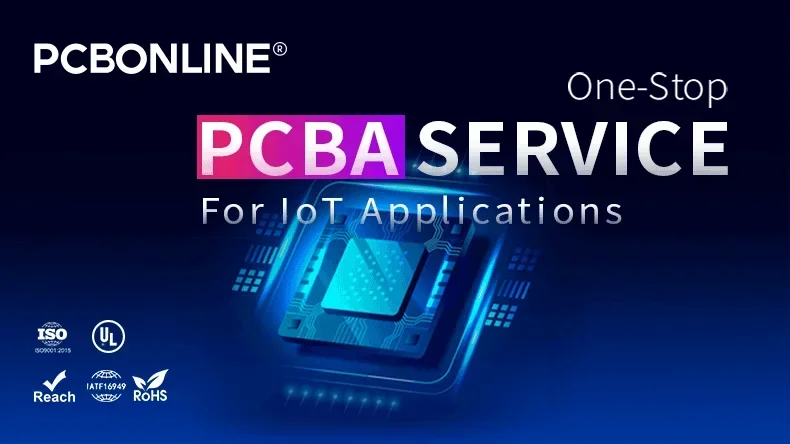
One-stop service: PCB fabrication, component sourcing, SMT/THT assembly, testing, IC programming, box-build assembly, and value-added until the finished product is delivered to you.
RF expertise: Specializing in RF board manufacturing for BLE, WiFi, and LoRa
Prototyping to mass production: From 1 to 1 million units — all under one roof
Design review & DFM support: Get feedback on your IoT PCB layout before mass production
Global shipping & logistics: Delivery to any clients around the world.
High quality: All the PCBs and PCBA manufacturing are under strict quality control and certified with ISO 9001:2015, ISO 14001:2015, IATF 16949:2016, RoHS, REACH, UL, IPC-A-610 Class 2/3, and IPC-A-610 Class 2/3.
Whether you're a startup creating a BLE wearable or an OEM deploying smart meters across cities, PCBONLINE offers turnkey PCBA services that help you go to market faster and more reliably. To get a quote for your IoT project, please email info@pcbonline.com.
Conclusion
Selecting the right wireless protocol for your IoT application isn't just about range or data speed's about aligning technology with purpose. Whether you're building a battery-powered sensor node for a vineyard or a cloud-connected energy meter, LoRa, WiFi, and BLE each offer unique advantages.
And once your design is complete, turn to trusted partners like PCBONLINE to manufacture, assemble, and test your PCB with the precision that IoT demands.
PCB assembly at PCBONLINE.pdf




